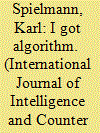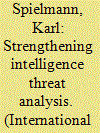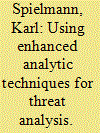| Srl | Item |
| 1 |
ID:
145322


|
|
|
|
|
| Summary/Abstract |
Nate Silver is a prominent statistician/statistical probability analyst who, among other achievements, may be best known for making a very accurate prediction of President Barack Obama's victory and its dimensions in the 2012 election.1 In doing so, he probably redeemed (at least partially) the reputation of sophisticated mathematical modeling that was badly tarnished by its association with the poor investment decisions that brought the financial debacle of 2008.2 Does Silver have a potential counterpart in the intelligence business, where predicting the nature and likelihood of threats is a central concern, and what would that person have to do to rise to the occasion?
|
|
|
|
|
|
|
|
|
|
|
|
|
|
|
|
| 2 |
ID:
111613


|
|
|
| 3 |
ID:
130232


|
|
|
|
|
| Publication |
2014.
|
| Summary/Abstract |
This is intended as an instructional supplement to a methodology I proposed in my earlier article "Strengthening Intelligence Threat Analysis." 1 Through the presentation of a hypothetical case study, I hope to facilitate analysts' use of that proposed methodology by walking them through the major tests that comprise its assessment process.
Accurately determining the nature and likelihood of a threat from terrorists or state actors can be very difficult, with high costs for failure. This proposed methodology is a tool to help analysts better provide clear, timely, and well-substantiated warning to key decisionmakers. Its assessment process has three tests, which build on each other to determine the strengths and weaknesses of different possible views on a threat. The first two tests yield important interim results, affording early intelligence inputs for decisionmaking. When completed, the testing provides a numerical basis for ranking competing views, enabling more precise and transparent judgments to be made on a threat's probability than is common practice.
|
|
|
|
|
|
|
|
|
|
|
|
|
|
|
|